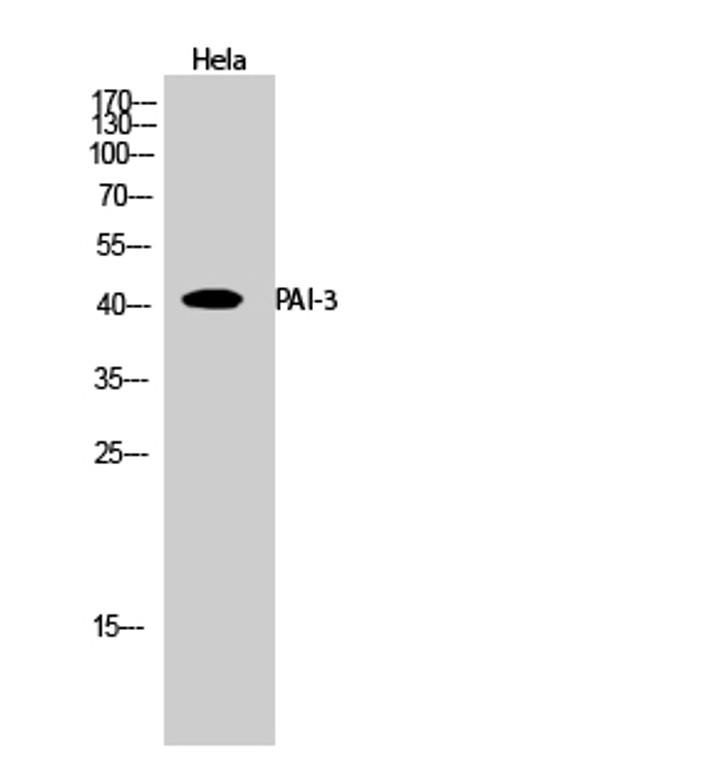| Host: |
Rabbit |
| Applications: |
WB/IHC/IF/ELISA |
| Reactivity: |
Human/Rat/Mouse |
| Note: |
STRICTLY FOR FURTHER SCIENTIFIC RESEARCH USE ONLY (RUO). MUST NOT TO BE USED IN DIAGNOSTIC OR THERAPEUTIC APPLICATIONS. |
| Short Description: |
Rabbit polyclonal antibody anti-Plasma serine protease inhibitor (260-309 aa) is suitable for use in Western Blot, Immunohistochemistry, Immunofluorescence and ELISA research applications. |
| Clonality: |
Polyclonal |
| Conjugation: |
Unconjugated |
| Isotype: |
IgG |
| Formulation: |
Liquid in PBS containing 50% Glycerol, 0.5% BSA and 0.02% Sodium Azide. |
| Purification: |
The antibody was affinity-purified from rabbit antiserum by affinity-chromatography using epitope-specific immunogen. |
| Concentration: |
1 mg/mL |
| Dilution Range: |
WB 1:500-1:2000IHC 1:100-1:300ELISA 1:20000IF 1:50-200 |
| Storage Instruction: |
Store at-20°C for up to 1 year from the date of receipt, and avoid repeat freeze-thaw cycles. |
| Gene Symbol: |
SERPINA5 |
| Gene ID: |
5104 |
| Uniprot ID: |
IPSP_HUMAN |
| Immunogen Region: |
260-309 aa |
| Specificity: |
PAI-3 Polyclonal Antibody detects endogenous levels of PAI-3 protein. |
| Immunogen: |
The antiserum was produced against synthesized peptide derived from the human Serpin A5 at the amino acid range 260-309 |
| Post Translational Modifications | N- and O-glycosylated. N-glycosylation consists of a mixture of sialylated bi- (including sialyl-Lewis X epitopes), tri- and tetra-antennary complex-type chains.affects the maximal heparin- and thrombomodulin-enhanced rates of thrombin inhibition. O-glycosylated with core 1 or possibly core 8 glycans. Further modified with 2 sialic acid residues. Proteolytically cleaved. Inhibition of proteases is accompanied by formation of a stable enzyme-inhibitor complex and by degradation of the serpin to lower molecular weight derivatives. Proteolytically cleaved at the N-terminus.inhibits slightly the heparin- and thrombomodulin-enhanced rates of thrombin inhibition. |
| Function | Heparin-dependent serine protease inhibitor acting in body fluids and secretions. Inactivates serine proteases by binding irreversibly to their serine activation site. Involved in the regulation of intravascular and extravascular proteolytic activities. Plays hemostatic roles in the blood plasma. Acts as a procoagulant and pro-inflammatory factor by inhibiting the anticoagulant activated protein C factor as well as the generation of activated protein C factor by the thrombin/thrombomodulin complex. Acts as an anticoagulant factor by inhibiting blood coagulation factors like prothrombin, factor XI, factor Xa, plasma kallikrein and fibrinolytic enzymes such as tissue- and urinary-type plasminogen activators. In seminal plasma, inactivates several serine proteases implicated in the reproductive system. Inhibits the serpin acrosin.indirectly protects component of the male genital tract from being degraded by excessive released acrosin. Inhibits tissue- and urinary-type plasminogen activator, prostate-specific antigen and kallikrein activities.has a control on the sperm motility and fertilization. Inhibits the activated protein C-catalyzed degradation of SEMG1 and SEMG2.regulates the degradation of semenogelin during the process of transfer of spermatozoa from the male reproductive tract into the female tract. In urine, inhibits urinary-type plasminogen activator and kallikrein activities. Inactivates membrane-anchored serine proteases activities such as MPRSS7 and TMPRSS11E. Inhibits urinary-type plasminogen activator-dependent tumor cell invasion and metastasis. May also play a non-inhibitory role in seminal plasma and urine as a hydrophobic hormone carrier by its binding to retinoic acid. |
| Protein Name | Plasma Serine Protease InhibitorAcrosomal Serine Protease InhibitorPlasminogen Activator Inhibitor 3Pai-3Pai3Protein C InhibitorPciSerpin A5 |
| Database Links | Reactome: R-HSA-140837Reactome: R-HSA-140875 |
| Cellular Localisation | SecretedExtracellular SpaceLocalized On The Plasma Membrane Overlying The Acrosomal Head Of Spermatozoa Of Ependymal Spermatozoa And Ejaculated SpermLocalized At The Equatorial Segment Of Acrosome-Reacted SpermatozoaLocalized In Alpha Granules In Resting Platelets And On The External Plasma Membrane And Within The Surface-Connected Cannalicular System In Activated Platelets |
| Alternative Antibody Names | Anti-Plasma Serine Protease Inhibitor antibodyAnti-Acrosomal Serine Protease Inhibitor antibodyAnti-Plasminogen Activator Inhibitor 3 antibodyAnti-Pai-3 antibodyAnti-Pai3 antibodyAnti-Protein C Inhibitor antibodyAnti-Pci antibodyAnti-Serpin A5 antibodyAnti-SERPINA5 antibodyAnti-PCI antibodyAnti-PLANH3 antibodyAnti-PROCI antibody |
Information sourced from Uniprot.org
12 months for antibodies. 6 months for ELISA Kits. Please see website T&Cs for further guidance










